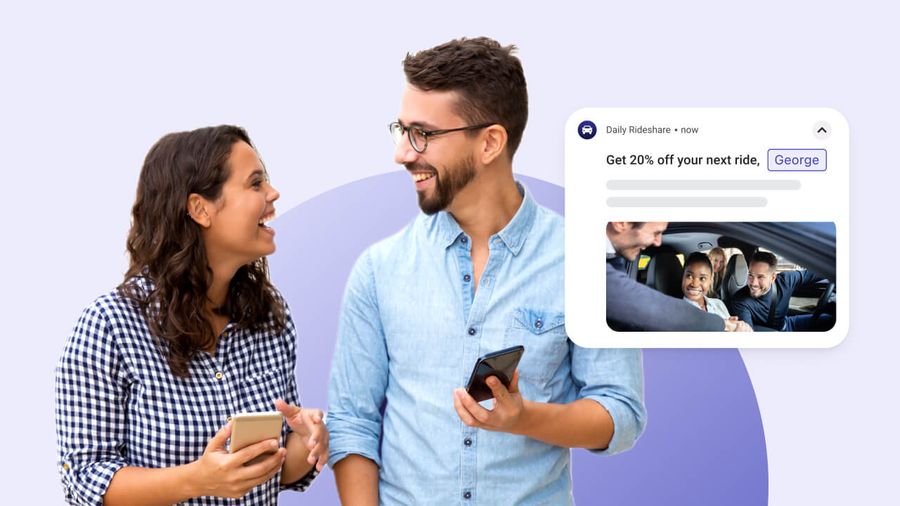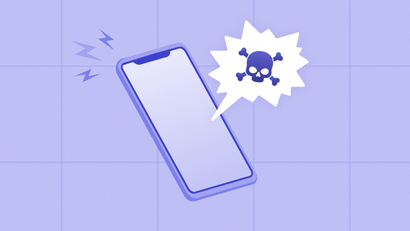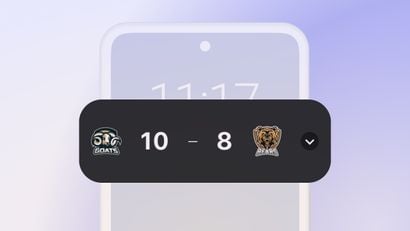What is App-Based Marketing?
Mobile app marketing is all about reaching your customers with the optimal messages and impressions at the ideal times throughout their lifecycle.
The process of marketing to your mobile app audience spans every touchpoint with across every funnel stage, from discovery to download to post-download. In today’s mobile app marketing ecosystem, the customer journey spans multiple channels, devices, and mediums, so devising the most effective strategy for acquiring, nurturing, and retaining users across these touchpoint can seem overwhelming.
That’s where your mobile app marketing strategy comes into play.
Why is Mobile App Marketing Important?
You could build the best app in the world, but without a proper full-funnel mobile app marketing strategy, you could fail to acquire and retain users, which can ultimately lead to the failure to monetize your mobile-first business.
Here are some stats that reinforce the importance of mobile app marketing throughout the customer lifecycle in today’s ecosystem.
- There were over 77 billion mobile app downloads in the first half of 2023, up 3% from the same period in 2022. In 2021, which not only indicates consumers’ appetite for mobile but also of growing competition in the mobile space.
- On top of that, acquiring a new user can now cost up to five times more than retaining an existing user
- User Retention rates tend to drop around the 7 and 30-day marks
- Reducing churn by only 5 percent can increase profitability by 75 percent
These statistics point to emerging trends of heightened competition, increased acquisition costs, and a shift away from paid advertising. They also highlight the importance of retention in today's mobile app marketing ecosystem.
App-Based Marketing vs. Mobile App Advertising
Unlike mobile app marketing, mobile app advertising refers to the process of delivering ads to users within mobile apps. Although these buzzwords may sound similar, this process is separate from mobile app marketing. Mobile app advertising can be a small piece of your mobile app marketing strategy, but these two terms are by no means the same.
More specifically, mobile app advertising lets developers make money on ad placements within their apps. This is a popular way that apps monetize their offerings.
What is Ad-Based Monetization?
An ad-based monetization strategy sells ad space by displaying ads on your platform. You can then offer a paid ad-free version of your app that removes ads. In the past, this mobile app strategy was highly popular and was used to drive a high volume of downloads, aggregate user data, and then sell it to app publishers. In recent years, this model is has declined in popularity with changes in privacy and an increased focus on retention over acquisition.
Although this approach is declining, companies still choose it incorporate ads into the app experience in a variety of ways. For example, some apps use interstitials, which are full screen ads with extra space for copy. Other options include banner ads, which appear at the top or bottom of a user’s screen and native ads, which are organic to the app experience.
With ad-based monetization models, you need to be careful not to deter users from using your platform by creating an overly distracting user experience. To make sure your ads are not irritating to users, make sure you target and personalize their content as much as possible.
How Do You Create a Marketing Plan for a Mobile App?
Creating a mobile app marketing strategy involves considerations that you may not initially be aware of.
Your mobile app marketing strategy needs to cover various phases of app launch, discovery, and post-download. Let’s get into some popular creative strategies that are proven to be effective within your mobile app marketing plan.
Mobile App Marketing Strategies that Work
1) Understand your Competition
Before you can effectively launch your app, you’ll want to assess your competition. First, identify who your top competitors are. Then, figure out what their marketing strategies are. Where do they appear in app listings? Do they have a robust knowledge base on their website? Are they running paid ads? What additional marketing channels are they using?
For example, if you’re a food delivery app, you’d likely want to download other popular apps in your category such as DoorDash or Grubhub. You google their company name and see what types of top-of-funnel content they have. You can then search them in the app store and identify what keywords they’re ranking for. You can download the app itself and see what communication channels they offer for placing and tracking an order.
You might find that in this industry, a common mobile marketing strategy is using a combination of push notifications and SMS to confirm and communicate about orders in the platform. After conducting this research on your competitors, you’ll better be equipped to measure up to the types of marketing they are deploying. This pre-launch strategy is also a helpful way to conserve marketing budget, because you are assessing the ecosystem before spending resources on channels that may not be effective for your mobile app.
2) Improve Your Onboarding Flows to Drive Retention
Effectively onboarding your users increases the chances that they get hooked on your app and continue coming back. Within your onboarding flow, you’ll want to market your app’s value prop through the appropriate messaging that engages and instructs users on how to leverage your platform.
To improve your onboarding process, ensure that you’re choosing the most intuitive onboarding style for your mobile app. Examples types of on boarding flows you can use include function-oriented, progressive, and benefits-oriented flows.
Using In-App Carousels to Improve the Onboarding Experience
In-app messaging is one channel you can use to effectively message your users with onboarding content
With a a multi-card onboarding flow, you can create an interactive onboarding sequence of messages to promote new features all without code. Using a no-code solution like OneSignal’s In-App Carousel allows you to launch updates in an efficient and scalable way and modify your marketing accordingly. These In-App Messages also offer built-in analytics that help you evaluate whether your on boarding messages are working.
Our Ultimate Guide to User Onboarding provides everything you need to create high-engagement welcome sequences across in-app, push, and email communications.
3) Optimize your App Store Listing
With App Store searches in the app store driving 67 percent of new downloads, App Store Optimization, or ASO, is a budding strategy in the mobile app marketing ecosystem.
Optimizing your app store listing makes it easier for your users to find and download your platform on both iOS and Android App stores. App Store Optimization increases the discoverability of your mobile app by placing you higher in search results, decreases acquisition costs by decreasing your reliance on paid advertising, and enabling you to reach global audiences through regional optimizations.
Although ASO differs slightly across the various available app stores depending on their unique algorithms, some examples of steps you can take to perform this process include optimizing your app name and title, including important keywords from your category, and including compelling visual elements in your app’s profile.
For instance, your delivery app might target keywords such as “food delivery,” “food and beverage,” and “order delivery.”
4) Segment and Personalize Your Marketing Messages
Segmenting your audience will be critical to your retention strategy, as you’ll need to cater to different users with different types of messages across the customer journey.
With personalization and segmentation, you can better show your users that you understand their needs. If you’re not already doing so, you should prioritize sending notifications that are relevant to a user’s buying stage, their known preferences, their specific behaviors, and their personal information.
A robust segmentation plan should always be data driven. You’ll want to aggregate and analyze your customer data and app interactions in order to have a factual basis for your campaigns. To do so, you can implement a variety of customer analytics and data platforms and integrate them with your app.
For instance, with a data and analytics provider such as Mixpanel, you can better segment users based on in-app purchase and sales data in order to send retargeted messages to users who have for example, made a single purchase in your app and who you’d like to incentivize to make a second purchase.
5) Encourage Ratings and Reviews
Reviews are increasingly important in users’ decision to download your app. 77 percent of users read at least one review before downloading a free app. Reviews also play into your ASO strategy, which means it’s worth your time to put energy into maximizing positive reviews and minimizing the negative ones.
For example, in order to convince your users to leave 5-star reviews, you can take steps such as tagging power users in your app and prompting them to evaluate your app within the app experience, through email campaigns, or using another channel such as SMS or web push notifications.
6)Retarget Users With the Right Messages
Retargeting is an excellent way to communicate with users based on their history of engaging, or not engaging, with previous messages from your mobile app.
Retargeting usually aims to get users to take a certain action, such as reentering your app, making a purchase, verifying their account, or confirming their order. Taking advantage of retargeting will allow you to incentivize more of the conversions that you’re seeking.
You can retarget users, for instance, with an email after they’ve performed a certain action in your app or a second push notification after they’ve failed to interact with your first push notification.
7) Devise a Mobile-First Engagement Strategy With Push Notifications
According to a report we conducted…
“The majority of businesses said that mobile push notifications are the most effective re-engagement channel for their business and the most important channel to their business overall.”
This is why we encourage you to put mobile-first engagement at the center of your mobile app marketing strategy. Push notifications can seamlessly drive your users back into the user experience after they’ve lapsed for a period of time. With the right provider, you can track user interactions within your app to understand where users typically churn from your app and re-engage them accordingly. Push notifications fill gaps in your user experience without the need to update your app.
For instance, maybe your gaming app users are churning from your app experience at Level 4. You can effectively prompt re-engagement with a push notification targeted at this friction point, without having to modify your in-app offering.
8) Think Omnichannel
By mapping your omnichannel customer journey, you can better understand and meet your customers’ needs across every communications touchpoint with your brand in order to draw them towards the desired objective. Customer journey maps visualize how a customer interacts with your brand by defining events, motivations, and friction points in their product experience.
An omnichannel approach to mobile app marketing means you’re taking into account the series of interactions a customer takes with your brand among the various channels you’ve deployed, including push notifications, SMS, email, in-app messages, and web notifications.
Unlike a fragmented approach, omnichannel messaging integrates communication across all customer touchpoints and views each channel interaction as part of one larger conversation.
One Mobile App Strategy, OneSignal
OneSignal is designed to help you send notifications and seamlessly manage your user communication across a variety of channels. Our platform is quick to set up and makes it easy to send push notifications, in-app rating requests and user surveys, and much more. If you don't have a OneSignal account, you can create one for free and start sending push notifications to your users today. Don't take our word for it — simply sign up and see for yourself!
Get Started for Free



